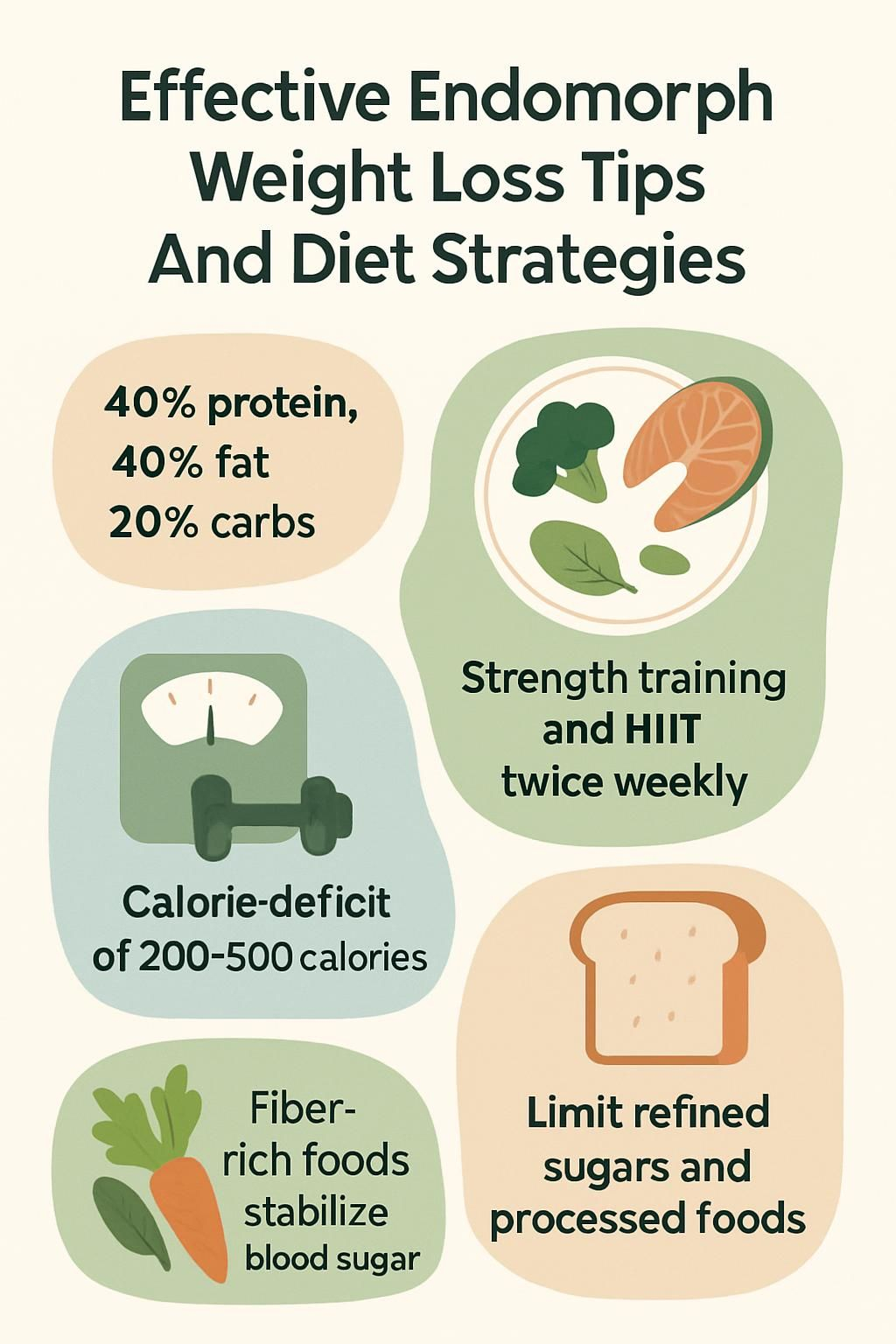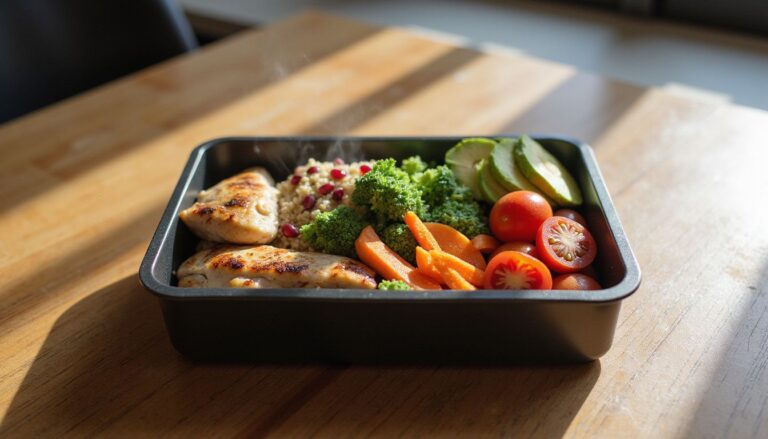Effective Endomorph Weight Loss Tips And Diet Strategies
Our Nutrition Assistant AI Suite will transform your body. You will lose fat, get toned, and build muscle. Gain confidence and optimal health.
You may gain weight quickly and find it hard to lose. That pattern is common for the endomorph body type, a somatotype, or body type system, that tends to store fat more easily. An endomorph diet and smart training plan can help you burn fat, feel energized, and protect your health.
This guide gives you clear steps you can use today. It blends research from the American Council on Exercise and studies such as Diabetologia 2012 with practical tips you can follow at home.
Key Takeaways
- Many endomorphs do well with a high-protein, lower-carb eating plan like paleo or keto. A sample macro split is 40% protein, 40% fat, and 20% carbs (Catudal).
- A daily calorie deficit of 200–500 below maintenance supports steady weight loss. Many adults start near 1,300–1,500 calories, then adjust based on results and guidance (ACE).
- Strength training plus two weekly HIIT sessions can raise metabolism and preserve muscle. Research in Diabetologia (2012) reports HIIT improves fat loss markers.
- Portion control, hydration, and fiber from greens and beans help steady blood sugar and increase fullness. These habits support those at risk for insulin resistance.
- Limit refined sugar, processed foods, and sugary drinks to reduce insulin spikes and new fat gain. Choosing whole foods supports better body composition.

Understanding the Endomorph Body Type

Body type can shape how you gain and lose weight. As an endomorph, your nutrition plan and exercise routine often need more structure and consistency.
What Are the Defining Traits of Endomorphs?
Endomorphs usually have a larger bone frame and a curvier build. Hips may be wider, the waist can look rounder, and joints may appear bigger. Fat often collects around the belly and waist.
Compared with ectomorphs or mesomorphs, muscle definition can be less visible at the same body weight. Many endomorphs are more sensitive to carbohydrates, which can raise insulin, a hormone that helps move sugar into cells. ACE notes that hormone patterns may make muscle gain slower for some people with this body type.
These traits can raise the risk of metabolic syndrome or type 2 diabetes if diet quality and activity stay low.
What Makes Weight Loss Difficult for Endomorphs?
Many endomorphs burn fewer calories at rest. Fat stores can rise quickly, especially at the waist. That pattern often pairs with insulin resistance, which means the body does not use carbs well and blood sugar climbs more easily.
High-carb eating can add fat faster for this group. Some studies in people with type 2 diabetes show that insulin resistance slows fat loss. Many endomorphs see better progress with controlled carbs, more protein, and regular training.
I noticed this myself as a teen. Traditional low-fat diets barely moved the scale. A shift to strength work and intervals helped me improve body composition over time.
What Are the Best Weight Loss Strategies for Endomorphs?
Fat loss can feel slow with this body type. A focused plan that manages food and training often works best.
- Choose a lower-carb, higher-protein diet such as paleo or keto to improve insulin control and use fat for fuel.
- Track calories closely during the first month. Many adults start near 1,300–1,500 calories, then adjust to protect energy and muscle.
- Keep a 200–500 daily calorie deficit. Small, steady deficits tend to last longer.
- Try a macro split near 40% protein, 40% fat, and 20% carbs if it fits your needs and labs.
- Blend strength training and cardio to lower belly fat and build skeletal muscle.
- Do HIIT two times per week. Intervals can beat steady cardio for time efficiency and fat loss.
- Drink water throughout the day. Hydration supports appetite control and performance.
- Use portion tools, like smaller plates or meal prep containers, to prevent silent overeating.
- Avoid crash diets. Fast drops in calories can cause muscle loss and bouncing weight.
- Eat smaller, frequent meals if it helps blood sugar and keeps cravings lower.
Key Diet Practices for Endomorphs
Food choices can help you lose fat and reveal more muscle. Aim for protein at each meal, colorful vegetables, and fiber-rich carbs in measured amounts.
Why Prioritize High-Protein, Low-Carb Foods?
Endomorphs often store fat quickly, especially around the belly. High-protein, low-carb meals increase fullness and help stabilize blood sugar. ACE suggests a 30% carbs, 35% protein, and 35% fat split. Coach Phil Catudal often uses 40% protein, 40% fat, and 20% carbs.
Fewer refined carbs can reduce insulin spikes and improve prediabetes risk. More protein helps protect muscle while in a calorie deficit. Cutting processed foods removes empty calories and improves diet quality.
I switched to a paleo-style plan with meat, fish, nuts, and vegetables. Energy felt steadier and cravings fell within a few weeks.
Protein keeps you full longer, while fewer carbs mean less stubborn belly fat.
How Do Healthy Fats Support Endomorph Diets?
Healthy fats can make meals more satisfying, which helps you stay on plan. Up to 40% of calories from fats can work for some people if total calories are controlled.
Choose sources like salmon, extra virgin olive oil, walnuts, almonds, macadamias, and egg yolks. These provide unsaturated fats that support hormones and heart health. They also help you feel full longer.
Pair healthy fats with protein for better adherence. Many lifters find this mix helps muscle hypertrophy, which is muscle growth, while cutting fat around the waist.
Which Fiber-Rich Foods Are Ideal for Endomorphs?
Leafy greens such as spinach and kale add volume with few calories. Zucchini, onions, asparagus, and tomatoes boost fiber and slow digestion. Beans and lentils, like black beans and chickpeas, bring both protein and fiber for better blood sugar control.
Whole grains, including quinoa, oats, and brown rice, offer complex carbs and fiber. Fruits like berries, apples, and pears give fiber with less sugar than many tropical fruits. Soups and salads that mix vegetables and legumes keep portions in check.
These choices can ease cravings and help maintain stable insulin levels during the day.
How Can Portion Control Aid Weight Loss?
Portion control matters because endomorphs may gain fat from even healthy foods if servings are large. A daily calorie reduction of 200 to 500 below maintenance supports steady fat loss. Many adults start near 1,300 to 1,500 calories, then adjust based on hunger, workouts, and progress.
Tracking portions prevents accidental overeating, which is common with nuts, oils, cheese, and large servings of lean protein. Studies in behavior and nutrition link portion awareness with better weight outcomes.
Hydration also supports control of appetite, which leads into the next tip.
What Is the Role of Hydration in Losing Weight?
Water helps your metabolism do its job and can reduce hunger. Replacing sweet drinks with water cuts sugar and calories, which supports a low-carb plan.
Water-rich foods like greens, cucumbers, and some fruits also add volume. A simple habit, drinking a glass of water before meals, often prevents overeating. I found that this one change reduced my afternoon snacking.
Simple, repeatable habits like drinking more water make the rest of your diet easier to follow.
What Foods Are Recommended for Endomorphs?
Nutrient-dense foods support weight loss and muscle gain. Think lean proteins, non-starchy vegetables, healthy fats, and measured servings of complex carbs.
Which Protein Sources Are Best: Chicken and Fish?
Chicken, turkey, and other lean meats provide high-quality protein with fewer calories. Fish like salmon and cod add omega-3 fats that support heart and circulatory health.
These foods fit both paleo and higher-protein plans. Grilled or baked versions make portion control easier than breaded options. Greek yogurt and cottage cheese offer quick, dairy-based protein.
When I swapped breaded chicken for grilled, it was easier to stick to my training tips and keep calories on target.
What Vegetables Should Endomorphs Eat?
Leafy greens such as spinach, kale, and romaine are high in fiber and low in starch. They help control hunger and support stable blood sugar.
Broccoli and cauliflower bring antioxidants and fiber. Asparagus, tomatoes, cucumbers, onions, zucchini, and bell peppers add color and texture. Steamed or roasted vegetables fill the plate without piling on calories.
Clients who eat at least two cups of non-starchy vegetables daily often report fewer cravings and better progress.
Which Healthy Fats Are Beneficial: Avocado and Nuts?
Avocado offers monounsaturated fat that supports hormone balance and fullness. Add slices to omelets or salads. Nuts and seeds, such as almonds, pistachios, pumpkin seeds, and sunflower seeds, make easy snacks. Nut and seed butters also work in small portions.
These options may lower cholesterol and support blood pressure. Using olive oil in dressings or for light cooking fits a balanced endomorph diet. They provide steady energy without spiking blood sugar.
What Complex Carbs Support Weight Loss: Quinoa and Sweet Potatoes?
Quinoa is a whole grain that contains all nine essential amino acids, which makes it a complete plant protein. It also provides fiber, magnesium, and iron. Energy releases slowly with quinoa, so blood sugar stays steadier.
Sweet potatoes bring fiber and vitamins A and C. The fiber helps with fullness, which supports portion control. Both foods offer sustained energy for workouts and daily tasks.
Other good choices include oats, beans, brown rice, and squash. These complex carbs, eaten in measured amounts, can support fat loss while fueling training.
What Foods Should Endomorphs Limit or Avoid?
Some foods make weight loss harder because they spike blood sugar or pack many calories into small portions. Cutting them can speed progress.
Why Cut Down on Refined Sugars and Processed Foods?
Refined sugars and processed foods raise blood sugar quickly. That surge triggers more insulin, which promotes fat storage. Items like white bread, white rice, pasta, bagels, candy, pastries, and sweet snacks are common culprits.
High-sodium snacks and fried foods also increase water retention. Rich, high-saturated-fat dairy can pile up calories without much fullness.
Focusing on whole foods over packaged items reduces insulin spikes, helps with cravings, and supports muscle-friendly meals.
How to Reduce High-Carb Snacks and Sugary Drinks?
Snack swaps make a big difference. Replace energy bars, milk chocolate, and sugary cereals with nuts, seeds, or crunchy vegetables. Choose water or herbal tea instead of soda or energy drinks.
Many soft drinks contain over 30 grams of sugar per serving. Alcohol adds extra calories and can slow metabolism. Prepare low-carb snack packs for busy days, like boiled eggs or celery sticks.
I replaced afternoon soda with sparkling water. The change cut crashes and helped me stay on plan.
Which Exercise Methods Work Best for Endomorphs?
Exercise helps your body use stored fat for energy. Think of training as your daily signal to burn more and keep muscle.
How Does Combining Strength Training and Cardio Help?
Strength training builds muscle mass, which raises your metabolism. Cardio, like brisk walking or cycling, burns additional calories and supports heart health.
ACE encourages a balanced approach that includes both. When I added weights and regular cardio, my energy improved and waist size dropped faster than with diet alone.
For most endomorphs, exercise is essential. Food changes alone rarely deliver the full result.
What Are the Benefits of High-Intensity Interval Training (HIIT)?
HIIT means short bursts of hard work followed by rest. Compared with steady cardio, intervals can burn more calories in less time and improve fitness faster.
A 2012 Diabetologia study found HIIT improved waist measures and fitness more than traditional steady-state training in certain groups. Two or three 20 to 30 minute sessions per week is often enough.
HIIT paired with a protein-rich, lower-carb plan fits a busy schedule and can accelerate fat loss.
Why Include Compound Exercises in Your Routine?
Compound lifts work many muscles at once. Deadlifts train legs, back, and core. Push-ups hit the chest, arms, and shoulders. Squats build glutes and thighs.
These moves burn more calories per minute than isolation work. Circuit formats, like 50 seconds on and 10 seconds off, increase intensity and keep your heart rate up.
In my plan, compound lifts produced faster results than single-joint moves alone.
How to Create a Consistent Exercise Schedule?
A clear schedule keeps training steady and reduces decision fatigue. Treat workouts like appointments you cannot miss.
- Set weekly targets, for example 3–5 cardio sessions of 30–45 minutes at low to moderate effort.
- Add strength or HIIT after you build a cardio base to protect muscle and metabolism.
- Block time on your calendar and honor it like any meeting.
- Alternate strength, HIIT, cardio, and rest days to prevent boredom and reduce injury risk.
- Track your sessions in a journal or app to spot patterns and wins.
- Use phone reminders to cue movement on busy days.
- Plan at least one rest day weekly for recovery and muscle repair.
- Get feedback from a trainer or coach if possible, then adjust your plan.
- Adapt to work shifts or family needs instead of skipping. Shorten the session if needed.
- Share progress with a friend or group to boost accountability.
These steps make consistency easier, which is crucial for long-term success.
How Can Endomorphs Manage Their Metabolism?
Small, steady changes protect your metabolism and make weight loss more sustainable. Think long game, not quick fixes.
Why Avoid Crash Diets for Sustainable Weight Loss?
Crash diets often slash calories too fast. That can lower metabolism and increase the odds of regaining weight. Research suggests deficits larger than 500 calories per day are hard to maintain long term.
For endomorphs, a controlled deficit of 200 to 500 calories tends to work better. It supports fat loss while preserving muscle and daily energy.
Extreme rules are also tough to live with. Moderate plans help you build habits you can keep.
How Do Smaller, Frequent Meals Benefit Metabolism?
Regular, balanced meals can reduce blood sugar swings. That steadiness lowers cravings and helps you avoid high-carb snacks.
Some people report better energy and fewer binges with this approach. Planning several small meals kept my focus during busy afternoons and made healthy choices easier.
If a ketogenic diet or another low-carb plan suits you, regular meal timing can support adherence.
What Does a Sample Meal Plan for Endomorphs Look Like?
This sample structure balances protein, vegetables, healthy fats, and measured carbs. Use it as a simple template you can customize.
What Is a Good Protein-Focused Morning Meal?
Scrambled eggs with spinach deliver about 18 grams of protein and plenty of fullness. Cottage cheese with almonds and cinnamon brings protein, healthy fat, and flavor.
Try an egg frittata with tomatoes, onions, and spinach that you make ahead. A Greek yogurt smoothie with berries and almond milk provides protein and antioxidants with fewer carbs.
On hectic days, grab two hard-boiled eggs and a handful of blueberries. Omelets with peppers, spinach, and avocado add fiber and healthy fats.
How to Balance Protein and Vegetables at Midday?
Choose lean protein and pair it with high-fiber vegetables. Add a small serving of complex carbs if you need steady energy for work or training.
- Kale salad with cucumbers, bell peppers, grilled salmon, and olive oil.
- Chicken and peppers stir-fry over a half-cup of brown rice.
- Grilled chicken with quinoa and mixed vegetables.
- Open-faced turkey and veggie sandwich with avocado on whole-wheat toast.
Mixing colors and textures keeps lunch interesting and satisfying.
What Are Healthy, Low-Carb Snack Options?
Nuts, seeds, and nut or seed butters are convenient and filling. Pair a small handful of sunflower seeds with a piece of fruit for a balanced snack.
Low-sugar fruits like berries work well. Deli turkey rolled with asparagus provides protein and fiber. Greek yogurt or cottage cheese adds protein between meals.
Having snacks prepped makes it easier to stay on track during long days.
What Should an Evening Meal Include for Weight Loss?
Dinner should center on lean protein and non-starchy vegetables, with healthy fats for flavor and fullness. Use low-carb sides if you want more volume without a spike in carbs.
Examples include turkey tacos in lettuce with avocado, white fish with olive oil, or salmon with roasted broccoli. Cauliflower rice is a simple swap for regular rice. A hearty vegetable and bean soup topped with grilled chicken can satisfy comfort food cravings.
I noticed better evening control when I ended the day with baked salmon and sautéed mushrooms instead of pasta.
Here are simple dinner building blocks:
| Main Component | Example Dinners |
|---|---|
| Protein | Turkey tacos in lettuce, white fish, salmon, chicken |
| Healthy Fats | Avocado slices, drizzle of olive oil |
| Non-Starchy Veggies | Broccoli, mushrooms, roasted cauliflower |
| Low-Carb Side | Cauliflower rice |
Balanced dinners like these help you maintain progress without crash dieting myths.
What Common Dietary Mistakes Should Endomorphs Avoid?
A few hidden traps can slow your results. Avoiding them protects your calorie budget and your mindset.
Why Avoid Overeating Healthy Foods?
Healthy foods still contain calories. Endomorphs may store extra calories more easily. A few extra handfuls of almonds can add hundreds of calories fast.
Portion control and tracking help you stay within your daily target. Using a food journal kept my snacking in check and improved results.
Research shows consistent tracking and smaller portions support steady fat loss.
How Important Is Consistent Exercise?
Regular workouts are vital for this body type. Diet alone often falls short. Exercise keeps your metabolism active and helps you maintain lean mass.
Aim for at least 150 minutes of moderate activity per week, plus two days of strength work. These habits reduce the risk of weight regain.
Why Steer Clear of Diet Pills and Fads?
Diet pills and fad diets promise speed, but they rarely deliver lasting results. Some products can affect sleep, heart rate, or mood. Extreme plans often cut entire food groups that your body needs.
Balanced, science-based steps are safer and more durable. Slow, steady changes helped me lose fat and keep it off without risking my health.
What Are the Benefits of Following an Endomorph Diet Plan?
A structured plan helps you lose weight and feel better day to day. Clear rules remove guesswork and build confidence.
How Does It Promote Lasting Weight Loss?
A small calorie deficit paired with higher protein and fewer refined carbs improves insulin sensitivity. That shift helps you burn more fat instead of storing it.
Whole foods, steady protein, and measured carbs support metabolism and protect muscle. This approach delivers slow, reliable progress rather than rebound weight gain.
In What Ways Does It Boost Energy Levels?
Protein, fiber, and healthy fats stabilize blood sugar, which reduces mid-day crashes. Lean chicken or fish provides lasting fuel. Avocado and nuts add energy without a sugar spike.
Balanced meals and steady hydration help you stay focused for training and daily tasks. Some studies suggest low-carb, high-protein meals can boost focus and energy for hours after eating.
How Can It Improve Muscle Definition?
Higher protein intake, combined with strength training, supports muscle repair and growth. Compound lifts like squats, lunges, and bench presses shape multiple muscle groups at once.
As body fat drops, muscle lines become clearer. After I moved to a high-protein, lower-carb plan with regular lifting, my arms and legs looked firmer within three months.
How to Track Progress and Stay Motivated?
Tracking turns effort into clear feedback. Small wins add up and help you push through plateaus.
Why Keep a Food Journal?
Logging meals improves portion control and keeps calories aligned with your goals. Patterns become clear, like which foods keep you full and which lead to overeating.
Journaling also shows how you feel after different meals. Those insights make adjustments simpler and faster.
How to Set Achievable Weight Loss Goals?
Set goals that fit your lifestyle and schedule. A 200 to 500 calorie daily deficit is a common starting point.
Use a tape measure along with the scale. Many health groups suggest a waist below 35 inches for women and below 40 inches for men. Break large goals into weekly targets you can hit.
Small wins build momentum and improve adherence.
How to Recognize and Celebrate Successes?
Focus on non-scale victories such as more energy, better sleep, or finishing a tough workout. Track waist changes or lab improvements like blood glucose.
Note each milestone in your journal. Celebrate with non-food rewards, like new workout gear or a fun activity. These habits keep motivation high over the long term.
Conclusion
Effective weight loss for the endomorph body type starts with a clear plan. Choose a protein-forward, lower-carb eating pattern with plenty of vegetables and healthy fats. Combine that diet with strength training, cardio, and a couple of HIIT sessions each week.
Stay hydrated, manage portions, and limit sugar and processed foods to support metabolism and better body composition. Track your intake and workouts so you can adjust quickly. With steady effort and realistic goals, energy rises while body fat falls.
Health note: Always consult a doctor or registered dietitian before major diet changes, especially if you have diabetes, hypertension, or other medical concerns.
FAQs
1. What are effective weight loss tips for people who carry weight as endomorphs?
People who carry weight as endomorphs benefit from a diet high in lean proteins, vegetables, and whole grains. Regular strength training and cardio help increase metabolism. Studies show that tracking food intake and setting realistic goals support long-term weight loss.
2. How does diet strategy affect weight loss for endomorphs?
A balanced diet with controlled portions helps manage weight for endomorphs. Research suggests that reducing refined carbohydrates and added sugars can improve fat loss. Eating smaller, frequent meals may help control hunger and energy levels.
3. Are there specific foods endomorphs should avoid when they carry weight?
Endomorphs should limit foods high in saturated fats, processed sugars, and refined grains. Data from nutrition studies indicate that these foods can slow metabolism and increase fat storage. Choosing nutrient-dense foods supports healthy weight management.
4. Can personal experience help guide endomorph weight loss strategies?
Personal experience often highlights the importance of consistency and patience when you carry weight as an endomorph. Many find that combining evidence-based diet changes with regular exercise leads to steady progress. Keeping a food and activity journal can reveal patterns and support motivation.







